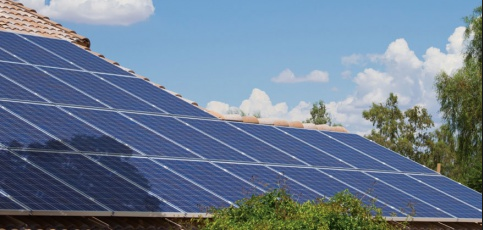Part 3: How does the Sunny Boy TL-US stack up against module-level systems?

Shining a light on shading
Today’s inverter marketplace is taking great pains to make homeowners believe even the slightest shade on one module could be catastrophic for a homeowner’s solar system. Thus, the only way to ensure energy production is by using module-level inverter equipment. However, thanks to advances in both modules, and more importantly, inverters, that’s simply not true anymore.
In the past, this theory has been referred to as the Christmas Tree Effect after the frustrating searching done by families for the one bad light that caused half of their Christmas tree’s lights to go dark. Just like today’s modern, efficient LED tree lights, solar systems don’t suffer from partial shade losses like they used to.
 Draft beer and power gains
Draft beer and power gains
Most pure-play module-level electronics companies boast about the amount of power their product will produce compared to a string inverter with modules in partial shade. The language is polished and sounds great, but the math doesn’t add up.
First, it’s important to understand that claims of additional power only pertain to power lost due to shading. That power gain is not an absolute gain but, rather, a gain only on the lost amount. Consider a draft beer right after it’s poured. The losses are the head at the top; considering many module-level companies estimate power gains north of 25 percent, that’s only a quarter of the froth, not 25 percent of the entire beverage.
Research from groups like Folsom Labs has pinned gains from systems using module-level electronics down to 13 percent of power recovered, less gains from systems that, on average, cost a few thousand dollars more than similar string inverter-based systems. Further reducing a customer’s ROI and increasing their payback time, things no one wants to hear.
More than just a string inverter
Good thing for today’s installers, the Sunny Boy TL-US with Secure Power Supply is more than just a string inverter. It comes with shade-busting OptiTrac Global Peak technology from our Denver, CO factory designed to mitigate the effects of partial shading.
Every six minutes the Sunny Boy TL-US checks its IV curve for any power point higher than its current one. If something is found, like a higher point than the first one created by shading, it tracks the higher point until its next sweep or the shade is gone.

One of the industry’s favorite images for module-level equipment could really use a Sunny Boy TL-US.
Flexibility from head to toe
The Sunny Boy TL-US features two fully-independent maximum power point tracking channels, each with two string combiners. When fully utilized, this inverter can handle 17 different stringing combinations for a 5kW system! Across the inverter’s power classes there are 45 combinations for systems ranging from 12-29 modules.
This is not the string inverter of yester-year. Installers can rest assured in telling their customers that partial shade, whether caused by early or late angle sun or an unmovable vent pipe to name a few options, is no longer more than a minor inconvenience.
At what cost
Slight gains are sometimes possible by using module-level equipment. SMA believes in the technology and provides the industry with the world’s most reliable micro inverter system, but total costs must be considered to see if those gains are worth it for your business or your customer’s returns. Though electric rates vary widely across the country, most research has pointed to small gains when compared to modern, less expensive string inverters, not accounting for the increased service risk of adding more electronic components to a system.
The next parts
Stay tuned for the next installments of How does the Sunny Boy TL-US stack up against module-level systems?, which delve further into cost considerations and operations and maintenance of residential arrays with module-level power electronics versus with the Sunny Boy TL-US with Secure Power Supply. If you missed the prior installments, click here for Part 1 or Part 2.





Imagine a single row of 12 PV modules in portrait connected in series to the SMA TL inverter. One of the modules in the string is partially shaded across the bottom row of cells for most of the day, impacting all 3 strings of cells on that module. Isn’t the current for that string significantly reduced in this situation? Would the Optitrack feature reduce the shading impact? How much power loss would you expect in this case?
How does the Sunny Boy TL-US handle NEC 2014 requirements, e.g. rapid shutdown?